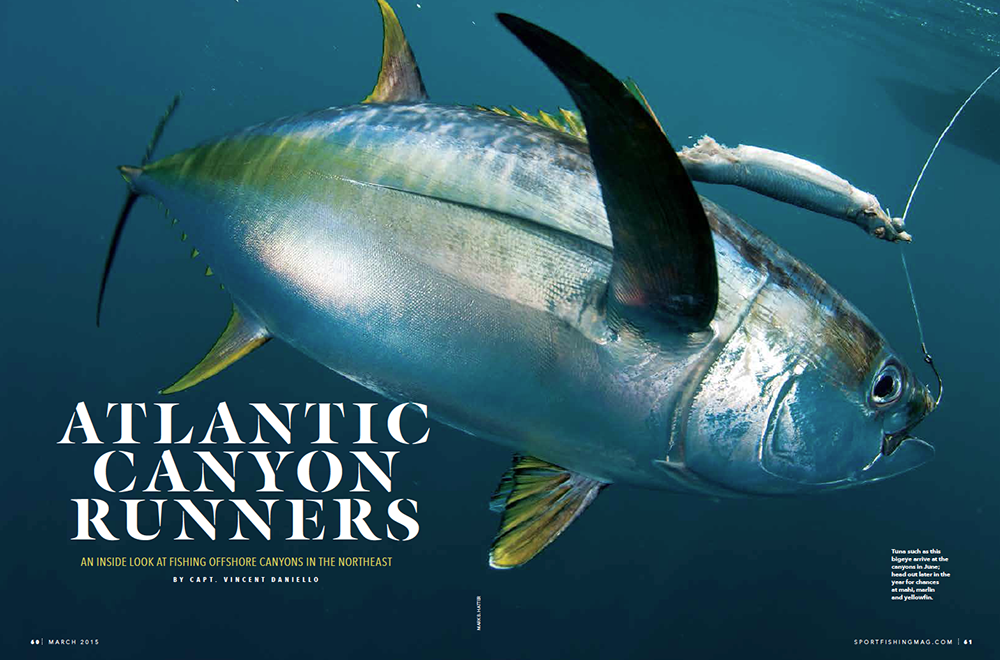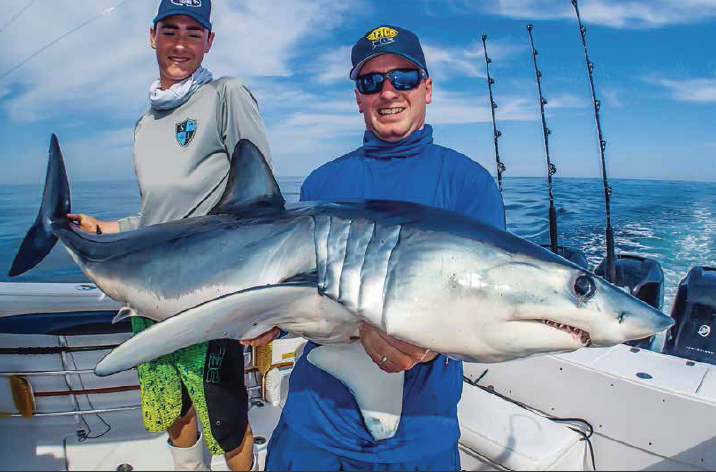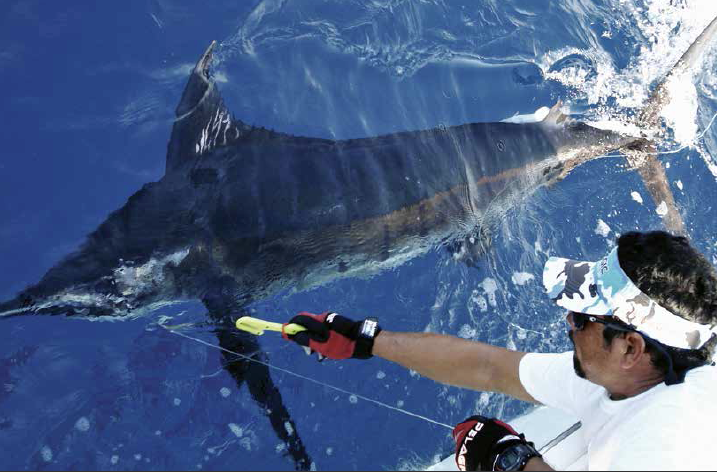Article by: Capt. Vincent Daniello | Sport Fishing Magazine – March 2015 | Please click here for original article.
SUBSEA CANYONS FORMED OFF THE NORTHEASTERN UNITED STATES WHEN SEA LEVELS WERE HUNDREDS OF FEET LOWER THAN TODAY, AND GREAT RIVERS CARVED VERTICAL WALLS DEEP INTO WHAT’S NOW CONTINENTAL SHELF. HUDSON CANYON, THE LARGEST NORTHEASTERN CANYON, IS MORE THAN 60 MILES LONG AND 7 MILES WIDE WITH VERTICAL WALLS EXTENDING 3,600 FEET FROM ITS RIM TO THE BOTTOM — A BIT MORE THAN HALF THE DEPTH AND ROUGHLY A QUARTER THE SIZE OF THE GRAND CANYON.
The sort of fishing and adventure that awaits out here just can’t be equaled near the coast, yet the canyons are surprisingly accessible. About a fifth of the U.S. population lives within a few hour drive of a port offering canyon charter trips. Boats cruising 25 knots cover the 50- to 150-mile ride out with time for a day of trolling, a night of chunking, and another half-day trolling before heading home.
For an inside look at this unique offshore fishery, I interviewed six pro captains operating from Maryland north through New Jersey and east to Long Island and Cape Cod.
“You have no idea what you’re going to get into,” says Ricky Wheeler, a freelance captain out of Pleasantville, New Jersey. “You might hook a 1,000?pound blue marlin, get double-digit shots at white marlin, or get covered up with dolphin and wahoo while fishing near floating debris. You’ll catch bigeye and yellowfin tuna trolling during the day. At night, you’ll get shots at swordfish and mako, along with more tuna.”
Above:Mako sharks often show when daytime trolling or nighttime chunking. They typically don’t bite plastic lures, so keep a bait ready.
In fact, it’s not uncommon to see all that action on a single, 24-hour trip. “When it’s on, there is no better fishing anywhere in the world,” Wheeler adds.
SEASONAL VARIATION
“June and July are best for yellowfin and bigeye tuna,” says John Oughton, based in Ocean City, Maryland, and the southernmost skipper of those contributing to this feature. White marlin average one shot per day early in the summer aboard his 50?foot Evans charter boat, That’s Right. Expect a tuna pattern of first bluefin followed by albacore and yellowfin tuna, and finally bigeye tuna, along 500 fishable miles of canyons from Virginia northeast to Canadian waters. Marlin and mahi mahi arrive with the yellowfin and peak in September.
Blue marlin might show in the spread anytime. “We catch about a half-dozen every season, but they’re big fish,” Oughton says, and they average 400 to 600 pounds. Mako sharks are most numerous in June and July, and as they fade in August, the swordfish bite improves. Wahoo fishing is best shortly before the full moon in August and again in September.
Seasonal variations affect not just what’s biting, but also how skippers fish. “Trolling for yellowfin is best from June 15 to July 10,” says Joe Trainor, whose 55?foot Gwaltney, Low Profile, is based in Avalon, New Jersey. As the water warms, yellowfin respond better to chunking at night and run-and-gun daytime chunking. “White marlin come in big numbers — sometimes 20 fish a day — for three weeks beginning in late August,” says Trainor.
There are geographic variations too. “In May we’re trolling during the day for bluefin and watching for mako,” says Paul Visentin, who runs charters on his 38?foot Northern Bay Provider out of Shinnecock, Long Island. “At night we put down a swordfish bait and sharkfish.” June brings more albacore and yellowfin; bigeye tuna show in July. “Around the middle of August, the tuna switch from a better trolling bite to a better chunking bite,” Visentin says.
“It all depends on the water,” says Dr. Mitchell Roffer, whose Roffer’s Ocean Fishing Forecasting Service has predicted worldwide current variations for fishermen for 26 years. Mahi mahi, tuna and billfish migrate north with the blue water of the Gulf Stream — which is typically well offshore of the canyons — looking for congregations of bait. As the Gulf Stream meanders, a large bend sometimes pinches closed and spins away from the main current as an eddy — a clockwise-rotating circle of warm blue water closer to the coast.
“That pulls nutrient-rich coastal water into the Gulf Stream water,” Roffer says. “Where that current interacts with bottom structure, it also generates upwellings that bring nutrients up into warmer water.” Baitfish thrive along those water boundaries as long as nearshore waters are warm enough to sustain them. “In the canyons east of Hydrographer, we see sharper temperature breaks,” says John Galvin who skippers Mulberry Canyon, a 40?foot Cabo express out of Falmouth, Massachusetts. “The cold Gulf of Maine water hits the Gulf Stream eddy,” he says, often creating 10-degree temperature gradients. “Farther west, where we see shelf water coming down, we might get only a 2-degree break, but I don’t mind less of a temperature change if it sits in one place longer, so there’s more time for an ecosystem to grow.”
Roffer says larger eddies, 60 to 90 miles wide, might take four months to drift westward from Galvin’s home waters to the Hudson Canyon, while smaller eddies, 30 miles wide, travel faster — although at any time the Gulf Stream might meander north and wash those eddies away. A few days of cloud cover that blocks satellite imagery can also affect forecasts. “The water will tell you a lot,” Galvin says. “I’m looking for weed lines or current edges, and watching water color. I’m also looking for life. Bait, whales, sea turtles, shearwaters and petrels — they are all good reasons to believe there are fish around.”
Other boats are also a factor, even this far offshore. “The way the water flows, yellowfin and bigeyes can get penned up in the northeast corner of a canyon,” Oughton says. “You’ll get 40 boats fishing a half-mile area.” June and July see fewer boats, as do weekdays. Offshore hurricanes from August though October can dramatically alter fishing, and while tuna are on the entire range of canyons into December, autumn weather cancels trips often.
SPREADS, RIGS AND ANGLING TECHNIQUES
Fishing techniques vary greatly within just 24 hours of canyon fishing. The morning might start with a traditional northeast trolling spread with Green Machine spreader bars, squid daisy chains, and ballyhoo behind skirts or Islander lures, totaling anywhere from eight to 14 trolling rods. “We do whatever works best,” says Brett Wilson, who runs his 42?foot Duffy, Hindsight, from Orleans, Massachusetts. For him that’s often a greenstick — a 50?foot fiberglass mast that acts as a vertical outrigger that produces spectacular bites from yellowfin and bigeye tuna. “At night we put a strobe light on the bird, and glow sticks on the main line,” Wilson says, sometimes achieving extraordinary results.
Wilson, Visentin and Galvin often troll traditional spreads at night. “I troll six lines with glow-in-the-dark Canyon Gear Hoo Machines over ballyhoo,” Galvin says. During the day, he increases to eight lines with a mixed spread of ballyhoo, marlin lures, an Islander daisy chain, a Green Machine spreader bar and two squid-chain teasers. “You’ve got to be able to switch gears and go with what’s happening,” he says. Large tuna call for bigger baits. For white marlin he trolls four naked, chin-weighted ballyhoo with pitch rods ready for the two squid-chain teasers. Wahoo bites add wire leaders behind trolling leads. “Sometimes we have a ball with spinning rods pitching to mahi under the high flyers (lobster pot buoys),” he says.
Anglers have to adapt as well, knowing, for example, when to drop back a ballyhoo to a white marlin, let a blue eat hard plastic, or pitch a ballyhoo or Moldcraft lure to a fish on the teaser. “Trolling at night, we’re targeting tuna with J hooks,” Galvin says. “They hook themselves with no drop-back.” When drifting and chunking, tuna strikes are never subtle, but swordfish bites are notoriously soft.
Most boats drift overnight with four to six rods — one far out and on top for mako, another rod or two deep off the transom for swordfish, and the rest weighted and held at varying depths with balloons for tuna. A handful of butterfish chunks are thrown leeward every few minutes, and live squid — caught in the lights off the transom — are the preferred bait.
“There is always something to do — catch bait, check tackle, drop a jig,” Visentin says. With any kind of sea, he puts a jig out 100 feet and hooks the line to an outrigger clip with half a dozen rubber bands chained together. “We’ve caught fish all night long like that, with the outrigger jigging the line.”
Trainor’s Low Profile is — unlike most canyon boats — set up to anchor in very deep water. Anchoring can be more comfortable than drifting. “When I’m anchored, I can get away with a lot less weight, 32 or 38 ounces,” he says, versus sometimes 60 ounces from a drifting boat. “I also have a chum bag out. If a mako misses the long bait, it will swim right up to that bag,” Trainor says, so a pitch bait is always ready. For daytime chunking, Trainor looks for pods of whales close together and very active, indicating they’re balling bait. “I might find 30 whales, put the lines in and get three yellowfin right away, and then go somewhere else to find more whales and catch three more.”
Above: When a big blue shows, it pays to have big teasers and big lures in the spread. Have at least one 80W ready to go.
Fighting big tuna from a drifting boat differs from fighting while the boat chases a fish. “When you put your rod in a belt, it’s not stuck there,” Wheeler says. “Stay mobile. Know how to back off the drag and go up around the bow if the fish goes there. Be ready to dip that rod to keep the line out of the running gear if the fish goes under the boat. If you think two lines are crossed, bring your tips together. That brings the tangle where you can see it.” Fighting 200?pound bigeye or bluefin tuna on 80?pound stand-up gear gets adrenaline flowing. “If you start doing curls with the rod, you’re whipped in five minutes,” Wheeler says. But even anglers small in stature can beat big fish with good technique.
TYPICAL TRIPS AND BOATS
Oughton runs a pretty typical 24-hour canyon trip. That’s Right makes its closest run — 50 miles to Poor Man’s Canyon — in two hours, and he seldom goes beyond Norfolk Canyon or Wilmington Canyon, both about 75 miles from home. “We leave before noon to take advantage of the afternoon and evening trolling bite,” Oughton says. He typically drifts and chunks overnight. “Then, we troll again at first light,” he says, “and we’re back at the dock around noon.” His boat is certified to carry 22 passengers, though he limits overnight trips to 10. Most fishing charter boats are limited to six passengers by law.
Trainer similarly runs Low Profile overnight charters from about 11 a.m. to 11 a.m., although he also offers a 2 a.m. departure for lines in at first light, and he returns to the dock as late as 6 p.m. His closest run is 65 miles to Wilmington Canyon, though he might travel 95 miles to Tom’s or Poor Man’s canyons.
Day trips are possible too. Wheeler, who frequently runs private boats, often leaves before dawn for lines in at first light, fishes all day, and returns to port around 7 p.m. This works particularly well for one client with a 27 Contender — about the smallest boat he’d consider. “We bring a life raft, satellite phone, EPIRB and lots of tackle,” he says. “To fit all that on a smaller boat is pretty tough.”
Runs become longer farther northeast. Visentin leaves at 6 a.m. to cover 75 miles to Block Canyon, his nearest canyon trip, for lines in around 10 a.m. Veatch’s Canyon, his farthest trip, is 115 miles. “I’ll leave earlier, even the night before, so we’re there at first light,” he says, “and we’ll be there for two full days.”
Galvin’s Mulberry Canyon is the fastest boat among canyon skippers contributing to this feature, with a 27-knot cruise, but his shortest run is 89 miles to West Atlantis. An 8 a.m. departure gets lines in at 11:30. With a stop in Nantucket for fuel, Galvin goes east to Lydonia Canyon, his farthest run.
Wilson’s Hindsight departs from the southeast corner of Cape Cod for the 95-mile run to Block or Veatch’s canyons, and he goes as far east as Lydonia. Wilson prefers to leave the night before to have lines in at first light.
NITTY-GRITTY
Averaging all five canyon skippers, charters run $3,500 for 24 to 30 hours, and $4,300 for longer trips (versus around $2,150 for a full day of fishing nearshore). Fares include tackle and ice, but not food — most captains suggest fried chicken, pizza or sandwiches with condiments on the side. Charter boats don’t allow glassbottle beverages, and several limit hard liquor. Snacks that can get wet are important when fishing is hot.
Tackle is best left home except for a favorite jigging setup and stand-up harness. Bring dry socks, boots, a sweatshirt, light rain jacket, and even a wool cap — it gets damp and chilly on the ocean overnight, even in August.
It’s also smart to prepare for the unexpected with extra prescription lenses and a few days’ supply of important medications. Take seasick meds beginning the night before the trip. Kids with experience offshore are fine, but novice adults might not have fun.
On nearly every trip, Mother Nature provides something spectacular. On one trip, Trainor trolled past a large chunk of debris and had 12 rods go down at once. “We fished it for six hours,” he says, catching two white marlin, six wahoo, three big mahimahi, yellowfin, albacore and scores of school mahi.
Oughton watched a quarter-ton swordfish and quarter-ton mako duke it out on the surface for 20 minutes. “I think the mako won, but it paid dearly,” he says. “The swordfish got in a few good slashes and got its bill into the mako at least once.” And the show doesn’t stop after dark, when Oughton and his anglers see tiny mahi, squid, sea turtles, porpoises, and rays. “It’s like Sea World in the lights behind the boat,” Wheeler says.
Want to see it for yourself? Block off the necessary days and head offshore — way, way offshore — to the productive canyons of the Northeast coast.
ABOUT THE AUTHOR:
Capt. Vincent Daniello grew up fishing and diving off South Florida. He used to run charters and private boats from Canada to the Caribbean. Now based in New Hampshire, he writes and shoots photos for boating and fishing magazines.








